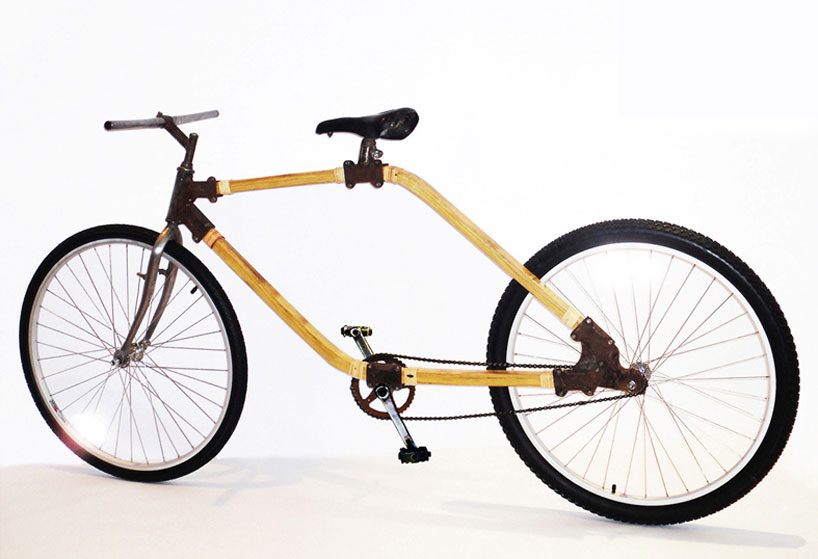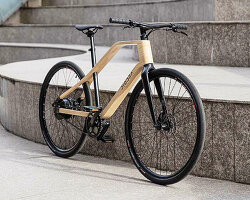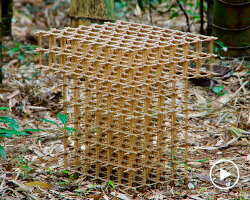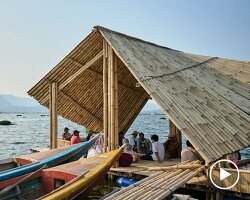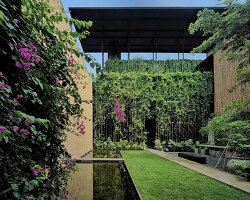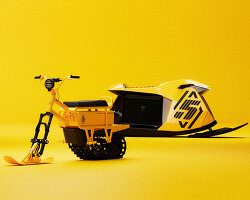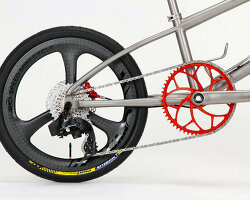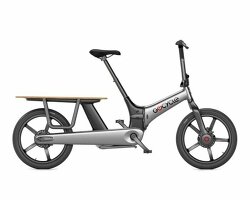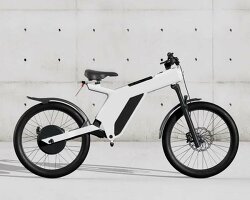greencycle prototype
as his master’s thesis project at the auckland university of technology paulus maringka has developed a series of bamboo bicycles under the name ‘greencycle’. the project applies a system approach to shift design thinking and practices away from the ongoing unsustainable use of resources towards a more sustainable framework of consumption whereby local cultures, skills resources and technology are analyzed to inform the design and development of a human powered transportation system. here is a look at the three bicycle prototypes that maringka has thus developed: greencycle, greencycle-eco and the G2.
maringka’s initial two year research study focused on looking at how to improve the bicycle manufacturing process so that it was cleaner and didn’t rely on unsustainable processes, together with exploring the use of renewable materials. through the study process and time spent in understanding the culture of users specifically in indonesia, his focus shifted. it became apparent that most bicycle manufacturers only cater to the middle and luxury ends of the market instead of producing ranges suitable to and affordable for the people who need this form of transportation the most – the lower income bracket, whose livelihood depends on it to make ends meet. most target users cannot even afford to buy a bicycle and their needs have been neglected for some time. therefore, maringka becane looking at ways of reducing manufacturing processes and costs while utilizing local resources and harnessing local craftsmen’s skills to produce a design outcome that would best suit target users and their needs, wants and ways of life.
 greencycle construction
greencycle construction
to understand the creation of the ‘greencycle’, a participatory approach was applied in the design process that included a series of interviews of the target users, prototype testing and field experiments with sustainable resources, in order to propose, design and evaluate the system. to gather knowledge and experiences of a society all stakeholders were consulted; including farmers, artisans, bamboo experts, engineers and manufacturers to provide insights that has enabled this research to produce a cohesive socio-technical system in indonesia. the design process applies system design thinking, informed by cultural insights, to improve on this form of human powered transportation, taking into account the behaviour, belief and value relevance, functionality, the needs and wants of the users and the use of appropriate technologies and environmental considerations.
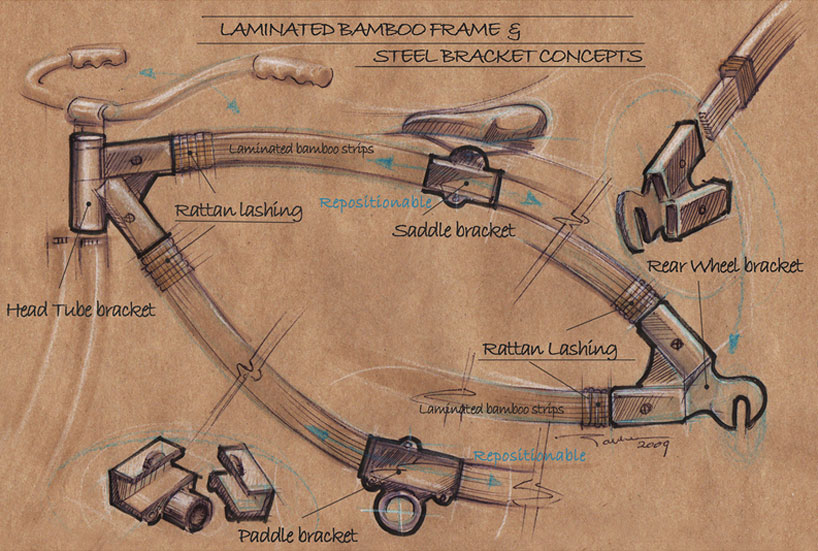 greencycle preliminary sketches
greencycle preliminary sketches
a laminating process was used to create the form for the bicycle frame as this is a relatively easy, economical and low technology process. two identical curved laminated bamboo pieces were placed in opposite directions and joined using simple steel brackets to produce a simple but yet very strong construction. this construction also allows for the seat and paddle bracket to be adjusted along the two curved frames to suit different users. rattan lashing was also used as a secondary binding to reinforce the laminated bamboo layers. the production and manufacturing of ‘greencycle’ was done in indonesia, using recycled parts.
 greencycle preliminary sketches
greencycle preliminary sketches
 greencycle-eco prototype
greencycle-eco prototype
high technology has the connotation of expensive costs and is normally associated with sophisticated products. ‘greencycle-eco’ explores the use of current technology to help reduce the production cost in order to make it affordable to farmers and the lower income demographic group in third world countries, while the strategic design thinking and model can be applied to any first world country to achieve greater sustainability. high technology was introduced to explore the possibility of simplifying the process.

greencycle-eco structure
pre-fabricated materials have been chosen for the ‘greencycle-eco’ design. bamboo panel products have been proven to be suitable for structural as well as non-structural applications in high grade building work. with the increasing demand for using greener and more highly renewable materials followed by recent technology developed in india and china, research studies and material testing has shown positive results for quality and mechanical strength. taking into consideration production costs, the design pattern of ‘greencycle-eco’ reduces the number of component parts to three different forms with two sets of identical parts being repeatedly cut out from a bamboo based panel product. each part is cut out using a CNC cutter; not only to get a consistent form and precision positioning of the screw holes, but to also maximize the material use and minimize material waste in the process. standard bamboo panel measuring 1200 x 2400mm can provide enough parts for eight bicycle frames which can be cut out in a short amount of time and reduce the production cost considerably. using a pre-fabricated bamboo panel product as the main material for ‘greencycle-eco’ offers a number of advantages including: 1. the product is made from a renewable material, abundantly grown and commonly available in asian countries 2. it has consistent quality 3. the whole bicycle can fit into a small flat-pack package making it economical to transport (reducing carbon footprint) if shipping is required.
 greencycle-eco design feature
greencycle-eco design feature
the steel brackets are created from flat steel and used as a joining component so they will last and can be reused again while the bamboo parts can be easily and cheaply replaced when needed. to increase the bicycle’s functionality and load capability, the following changes have been made as part of the design features of the ‘greencycle-eco’: 1. frame length increased by 20% to allow for more surface area to carry loads without compromising the stability, maneuverability and safety of the user 2. changing the shape of the downward angled seat stays of the traditional bicycle created an opportunity to provide not only a support for the rear seat but the point of attachment needed to give the target user freedom to develop or customize their bicycle and turn this humble people mover into a form of transportation which better suits their needs and wants without compromising its functionality as a form of transportation or operational safety.
 greencycle-eco
greencycle-eco
 G2 with attachment
G2 with attachment
featured in the top 20 for the 2011 international bicycle design competition, the ‘greencycle 2nd generation’ or ‘G2’, the bike challenges current practices to transform human-power transportation design. a culture-centric approach is used to shift design thinking and practices away from the ongoing unsustainable production of goods and services that are unfit for the human conditions in poor countries.
 G2 with splayed rear wheels
G2 with splayed rear wheels
the bicycle provides more than a basic transportation to go from A to B. poor countries need and depend on this mode of transportation for a wide range of uses. expanding its functions and uses would be of great benefit to the society. a series of ‘greencycles’ and accessories were created in the design process to extend the artifact’s functionality, with the core parts made from renewable materials such as the mighty ubiquitous bamboo that is available abundantly in many third world countries. pre-design information gathered from observation, interviews and participatory design approach of target users and bicycle manufacturers in indonesia offered insights on how low income users modify their bicycles to maximize their personal needs. the focus of human-centric design is to improve the usability of a product or service so that it becomes more related and meaningful to the user’s way of life.  G2 splayed rear wheels configuration
G2 splayed rear wheels configuration
the ‘G2’ incorporates the following optimum features: 1. an extra wheel for stability – going from a two wheel to a three wheel design to create a triangular base that is stable and strong for heavy loads 2. the ability to convert back to a two wheel configuration style when the terrain requires tight negotiation – like a narrow pathway through a padi field or poor road conditions as commonly found in third world countries 3. a splayed rear wheel base to provide a stable surface for load storage / carrying which conventional bicycles don’t have 4. provision for a basic frame for further customization depending on the user’s needs and wants, such as a hawker’s stand 5. a splayed rear design has given an opportunity for a further fixing point for additional attachments 6. an attachment that has a dual purpose as a wheel barrow for loading goods and as a trailer for carrying goods 7. an s-frame shape instead of a diamond frame shape to free up and create as much space for loading 8. a strong central core acting as an anchor for other attachments, such as a people carrier 9. a stronger wheel design 10. double front spokes to mimic the old style bicycle frame which has reinforced steel front forks 11. the main frame components made from environmentally friendly composite bamboo based materials which can be molded to produce the desired form. for this project it would have been a simple process for the designer to come up with a concept that was based on a personal view of what would be a suitable solution for the target users. instead, human-centered research methods were used to capture knowledge and feedback from the target group participants to shape and develop the design process and to ensure the design will not only be acceptable, but also culturally meaningful and desirable for the users to use. this knowledge was later used to explore a series of new bicycle concepts and bicycle accessories to increase the bicycle’s functionality and load capability aimed at improving the user’s way of life. understanding this cultural relevance in the analysis, design and evaluation process also ensure that ‘G2’ is materially, economically and environmentally sustainable.
 G2 two wheels configuration
G2 two wheels configuration
 G2 design features
G2 design features
 greencycle 2nd generation
greencycle 2nd generation
designboom has received this project from our ‘DIY submissions‘ feature, where we welcome our readers to submit their own work for publication.
BAMBOO ARCHITECTURE AND DESIGN (354)
BIKE DESIGN (611)
PRODUCT LIBRARY
a diverse digital database that acts as a valuable guide in gaining insight and information about a product directly from the manufacturer, and serves as a rich reference point in developing a project or scheme.
